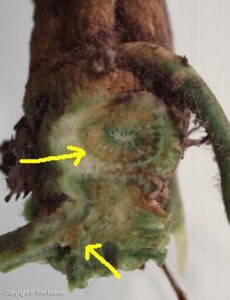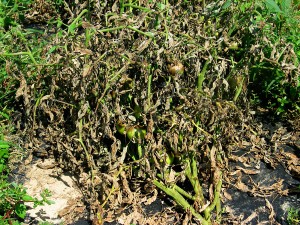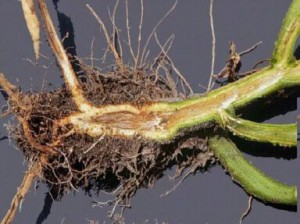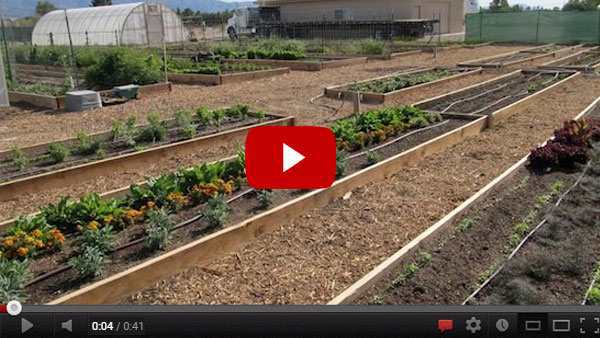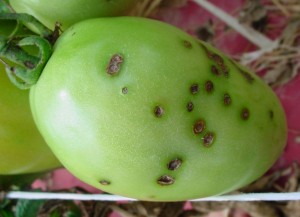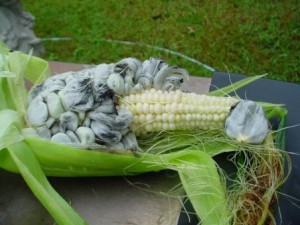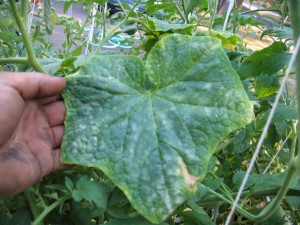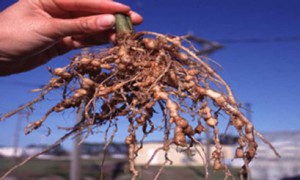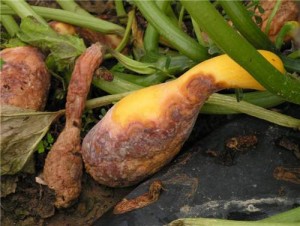Vegetable Diseases
Actually, dozens of diseases may afflict a vegetable garden, but fungus, bacterial, viral and environmental factors that cause root rot are the most common to vegetable gardens planted across the United States. Diseases caused by fungus are among the most prevalent to plague vegetable garden planters and growers, and can turn a once thriving and flourishing garden into a disaster.
The most important task is to prevent an occurrence of pests and diseases in the first place rather than having to react to them. In fact, once a pest or disease establishes itself on your crops there is often very little you can do to control it effectively. Protecting your plants from pests and diseases begins long before the crops are sown or planted in your garden.
1. Fusarium Wilt of Tomatoes – caused by the fungus Fusarium oxysporium lycopersici. The main symptoms are brown discolorations of the vascular tissue in the stem (see picture) and gradual yellowing and wilting of the entire plant. This fungus survives in the soil for many years. At least two races of the fungus are present in the United States. Many of the newer tomato varieties show good resistance to Race 1. However, not all existing tomato varieties have this resistance. Many other plants are affected by forms of Fusarium sp., but the form that attacks tomato is specific to tomato.
2. Southern Blight of Tomatoes – caused by the fungus Sclerotium rolfsii. Distinguishing sign is white mold, often with “seedlike” sclerotia, present on infected stem near soil line. This fungus also causes rot of tomato and other plant parts in contact with soil. The fungus lives in the soil for many years. It causes wilting and dying of many different kinds of plants. Southern blight is more common in the South in hot summer months. Tomato varieties have poor resistance to this disease.
3. Bacterial Wilt of Tomatoes – caused by the bacteria Pseudomonas solanacearum. Rapid, sudden wilting of the entire plant denotes this disease. Pith of the main stem near soil line is usually brown at first, but soon develops a slimy rot.
Bacteria attack numerous other plants, especially in the Solanaceae (night shade) and legume families, and may live in soil for many years. Wilt is more apt to be a problem on newly cleared land or fields that have been in weeds for several years. Tomato varieties show poor resistance.
4. Early Blight of Tomatoes – caused by the fungus Alternaria solani. This disease usually begins on lower leaves and gradually spreads upward. Concentric rings (targetlike) that develop in leaf and stem spots are characteristic. The fungus may live in soils for 1 or 2 years. In addition, it is spread on transplants and by windblown spores. It may appear on fruit, mainly as firm, dark-colored decay at stem end. Some of the newer tomato varieties have a moderate degree of resistance.
5. Gray Leaf Spot of Tomatoes – caused by the fungus Stemphylium solani. Characteristic symptom is numerous, rounded leaf spots, brown with gray centers, which are smaller than those of early blight. These spots often grow together to kill the entire leaf. The disease does not occur on the fruit. The fungus may live for 1 or 2 years in the soil. It can be spread on transplants and by windblown spores. Good resistance is found in some of the newer varieties.
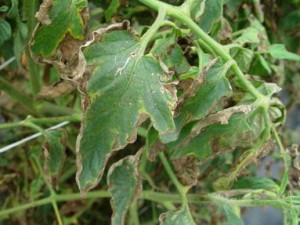
6. Corn Smut – caused by the fungus Ustilago maydis. Smut is a common disease of both sweet and field corn, but usually causes only minor crop loss. It may affect ears, stalk, leaf, and tassel, but it invades only young tissues.
The fungus can live in the soil 1 or 2 years and is spread by wind and water. Some varieties show good resistance.
7. Powdery Mildew – caused by fungus Erysphe sp. Many different plants are attacked by the powdery mildews, but in general each powdery mildew fungus is restricted to a few closely related host species. White, moldy growth mostly on upper leaf surface is characteristic. It does not usually develop on the fruit. The fungus is spread long distances by wind. Varieties of many crops are resistant.
8. Nematode Rootknot – caused by the nematode Meloidogyne sp. Distinguishing symptom is galls on roots. Affected plant becomes unthrifty, off-colored, stunted, and may eventually die.Greatest damage is likely to occur during dry periods. Rootknot is common in both field and garden soils and attacks a wide variety of plants. Resistance is found in some crops. Control is mainly by soil fumigation and by cultural methods.
9. Stem and Root Rot on Bean – caused by the fungus Rhizoctonia solani. Characteristic symptom is reddish-brown lesions or rots on stem near or below soil line. The entire root system may be rotted. Affected young bean plants appear stunted and off-colored, and may slowly die.
10. Downy Mildew – caused by several different genera and species of fungi. Distinguishing sign is downy fungal growth on the underside of leaf spots in wet, humid weather, particularly in the early morning.
Yellow spots first develop on upper side of leaf. The fungus that attacks cucurbits does not overwinter in South Carolina but moves northward in late spring and early summer as windblown spores.
11. Squash Fruit Rot – caused by the fungus Choanephora cucurbitorum. Dense, black fuzzy mold on the surface of rotted fruit or flowers denotes this rot. It does not affect leaves and stems. This disease is a problem primarily during periods or high humidity and on crowded vigorous plants.
Vegetable Pests & Diseases
Vegetable Pest and Disease Control & Prevention
The aim of any organic gardener is to create a healthy garden by making the soil fertile and by increasing biodiversity.
The most important task is to prevent an occurrence of pests and diseases in the first place rather than having to react to them. In fact, once a pest or disease establishes itself on your crops there is often very little you can do to control it effectively. Protecting your plants from pests and diseases begins long before the crops are sown or planted in your garden.
Find out how more than 78,000 Americans have greatly benefited from this amazing creation, and found energy independence, Click Here!
What keeps your plants healthy?
Soil fertility –
A healthy soil produces healthy plants. The care of your soil is the most important duty of every gardener. It is the most effective method of preventing a pest or disease outbreak. The ideal soil is a loose, moist humus rich soil full of worm and other soil life with a balanced nutrient content, including all the trace elements. It may take a good few years to achieve this, but even the poorest soil can be made very fertile using organic methods.
Biodiversity-
A garden with good biodiversity is a lot less prone to sudden attacks of pests and diseases as there is a balance of pests and predators. To increase the biodiversity in your garden is probably one of the most rewarding pleasures in gardening as you have the opportunity to create habitats and homes for many living creatures that have been pushed to the edge either through the destruction of their habitats or chemical poisoning.
Beneficial habitats include: – Pond – Log or branch pile – Dry stone wall or stone pile – Native hedgerow and include fruiting shrubs – Native trees – Clump of nettles in the corner of your garden – Wildflower patch
Apart from creating specialist habitats you can also increase the biodiversity within your vegetable patch through:
– Crop rotations – where pests and diseases are eliminated by prolonged periods without their hosts.
– Polycultures by growing different crops next to each other (inter-cropping) or undersowing with a green manure crop (under-cropping).
– Variety mixtures- by growing different varieties of the same vegetable in a plot. This technique has been very successful with potatoes and lettuce and there is a lot of scope for further experiments.
Some have seen this problem coming for a long time and changed their entire way of life by going off-grid. They have found alternative sources such as solar, wind and diesel to power their homes and machinery. A majority of us, who have not gone off-grid, are making a concerted effort to avoid dependence on this ailing infrastructure and preparing for life without it.
Discover how to survive: Most complete survival tactics, tips, skills and ideas like how to make pemmican, snow shoes, knives, soap, beer, smoke houses, bullets, survival bread, water wheels, herbal poultices, Indian round houses, root cellars, primitive navigation, and much more at: The Lost Ways
The Lost Ways is a far-reaching book with chapters ranging from simple things like making tasty bark-bread-like people did when there was no food-to building a traditional backyard smokehouse… and many, many, many more!
Here’s just a glimpse of what you’ll find in The Lost Ways:
From Ruff Simons, an old west history expert and former deputy, you’ll learn the techniques and methods used by the wise sheriffs from the frontiers to defend an entire village despite being outnumbered and outgunned by gangs of robbers and bandits, and how you can use their wisdom to defend your home against looters when you’ll be surrounded.
Native American ERIK BAINBRIDGE – who took part in the reconstruction of the native village of Kule Loklo in California, will show you how Native Americans build the subterranean roundhouse, an underground house that today will serve you as a storm shelter, a perfectly camouflaged hideout, or a bunker. It can easily shelter three to four families, so how will you feel if, when all hell breaks loose, you’ll be able to call all your loved ones and offer them guidance and shelter? Besides that, the subterranean roundhouse makes an awesome root cellar where you can keep all your food and water reserves year-round.
From Shannon Azares you’ll learn how sailors from the XVII century preserved water in their ships for months on end, even years and how you can use this method to preserve clean water for your family cost-free.
Mike Searson – who is a Firearm and Old West history expert – will show you what to do when there is no more ammo to be had, how people who wandered the West managed to hunt eight deer with six bullets, and why their supply of ammo never ran out. Remember the panic buying in the first half of 2013? That was nothing compared to what’s going to precede the collapse.
From Susan Morrow, an ex-science teacher and chemist, you’ll master “The Art of Poultice.” She says, “If you really explore the ingredients from which our forefathers made poultices, you’ll be totally surprised by the similarities with modern medicines.” Well…how would you feel in a crisis to be the only one from the group knowledgeable about this lost skill? When there are no more antibiotics, people will turn to you to save their ill children’s lives.
If you liked our video tutorial on how to make Pemmican, then you’ll love this: I will show you how to make another superfood that our troops were using in the Independence war, and even George Washington ate on several occasions. This food never goes bad. And I’m not talking about honey or vinegar. I’m talking about real food! The awesome part is that you can make this food in just 10 minutes and I’m pretty sure that you already have the ingredients in your house right now.
Really, this is all just a peek.
The Lost Ways is a far–reaching book with chapters ranging from simple things like making tasty bark-bread-like people did when there was no food-to building a traditional backyard smokehouse… and many, many, many more!
Books can be your best pre-collapse investment.
The Lost Ways (Learn the long forgotten secrets that helped our forefathers survive famines,wars,economic crisis and anything else life threw at them)
Survival MD (Best Post Collapse First Aid Survival Guide Ever)
Conquering the coming collapse (Financial advice and preparedness )
Liberty Generator (Build and make your own energy source)
Backyard Liberty (Easy and cheap DIY Aquaponic system to grow your organic and living food bank)
Bullet Proof Home (A Prepper’s Guide in Safeguarding a Home )
Family Self Defense (Best Self Defense Strategies For You And Your Family)
Survive Any Crisis (Best Items To Hoard For A Long Term Crisis)
Survive The End Days (Biggest Cover Up Of Our President)
Drought USA (Discover The Amazing Device That Turns Air Into Water)
SOURCE : virtual.clemson.edu / greenvegetableseeds.com


